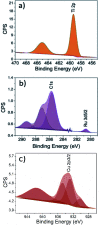Hierarchical hyper-branched titania nanorods with tuneable selectivity for CO2 photoreduction
- PMID: 35495501
- PMCID: PMC9041433
- DOI: 10.1039/d1ra05414g
Hierarchical hyper-branched titania nanorods with tuneable selectivity for CO2 photoreduction
Abstract
Utilising captured CO2 and converting it into solar fuels can be extremely beneficial in reducing the constantly rising CO2 concentration in the atmosphere while simultaneously addressing energy crisis issues. Hence, many researchers have focused their work on the CO2 photoreduction reaction for the last 4 decades. Herein, the titania hyper-branched nanorod (HBN) thin films, with a novel hierarchical dendritic morphology, revealed enhanced CO2 photoreduction performance. The HBNs exhibited enhanced photogenerated charge production (66%), in comparison with P25 (39%), due to the unique hyper-branched morphology. Furthermore, the proposed HBN thin films exhibited a high degree of control over the product selectivity, by undergoing a facile phase-altering treatment. The selectivity was shifted from 91% towards CO, to 67% towards CH4. Additionally, the HBN samples showed the potential to surpass the conversion rates of the benchmark P25 TiO2 in both CO and CH4 production. To further enhance the selectivity and overall performance of the HBNs, RuO2 was incorporated into the synthesis, which enhanced the CH4 selectivity from 67% to 74%; whereas the incorporation of CuO revealed a selectivity profile comparative to P25.
This journal is © The Royal Society of Chemistry.
Conflict of interest statement
There are no conflicts to declare.
Figures







Similar articles
-
Ultrathin-Film Titania Photocatalyst on Nanocavity for CO2 Reduction with Boosted Catalytic Efficiencies.Glob Chall. 2018 Sep 19;2(11):1800032. doi: 10.1002/gch2.201800032. eCollection 2018 Nov. Glob Chall. 2018. PMID: 30546916 Free PMC article.
-
Highly selective CO2 photoreduction to CO on MOF-derived TiO2.RSC Sustain. 2023 Feb 17;1(3):494-503. doi: 10.1039/d2su00082b. eCollection 2023 May 11. RSC Sustain. 2023. PMID: 37215582 Free PMC article.
-
Modulation of the Reduction Potential of TiO2- x by Fluorination for Efficient and Selective CH4 Generation from CO2 Photoreduction.Nano Lett. 2018 Jun 13;18(6):3384-3390. doi: 10.1021/acs.nanolett.8b00197. Epub 2018 May 2. Nano Lett. 2018. PMID: 29701060
-
Recent Advances in TiO2-Based Heterojunctions for Photocatalytic CO2 Reduction With Water Oxidation: A Review.Front Chem. 2021 Apr 15;9:637501. doi: 10.3389/fchem.2021.637501. eCollection 2021. Front Chem. 2021. PMID: 33937191 Free PMC article. Review.
-
Recent Progress on Nanostructured Layered Double Hydroxides for Visible-Light-Induced Photoreduction of CO2.Chem Asian J. 2020 Nov 2;15(21):3380-3389. doi: 10.1002/asia.202000963. Epub 2020 Oct 6. Chem Asian J. 2020. PMID: 32909699 Review.
References
-
- Chang X. Wang T. Gong J. Energy Environ. Sci. 2016;9:2177–2196. doi: 10.1039/C6EE00383D. - DOI
-
- Liu L. Zhao C. Xu J. Li Y. Appl. Catal., B. 2015;179:489–499. doi: 10.1016/j.apcatb.2015.06.006. - DOI
-
- Osterloh F. E. ACS Energy Lett. 2017;2:445–453. doi: 10.1021/acsenergylett.6b00665. - DOI
-
- Thompson W. A. Sanchez Fernandez E. Maroto-Valer M. M. ACS Sustainable Chem. Eng. 2020;8:4677–4692. doi: 10.1021/acssuschemeng.9b06170. - DOI
-
- Shankar R. Sachs M. Francàs L. Lubert-Perquel D. Kerherve G. Regoutz A. Petit C. J. Mater. Chem. 2019;7:23931–23940. doi: 10.1039/C9TA02793A. - DOI
LinkOut - more resources
Full Text Sources

